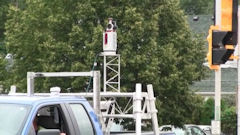Here’s how state highway departments do their project design work: An engineer sits at a work station equipped with Microstation 3-D modeling software and downloads topographical data provided by VDOT surveyors. To get new data, the engineer sends a request over to the surveying department. When a surveyor is available, he is dispatched to the site where he takes the measurements. Sometimes the surveyor, using his best judgment, gets everything the engineer wants. Sometimes not, and he has to be dispatched again. Then the engineer starts tinkering with the design. Often he (or she) realizes he needs more information, and he issues another request to the surveying department. It’s not unusual for the process to take weeks.
3-D modeling software has dramatically increased engineer productivity, and GPS tools have dramatically increased surveyor productivity. But neither can do much to improve the clumsy interface between the two. Along comes TopoDOT, a Microstation plug-in created by Certainty 3-D, a start-up company in Orlando, Fla. All it takes is driving down the road and pausing periodically for the laser scanner in the truck bed to sweep the area. TopoDOT’s technology dumps the data into Microstation for instant access. Engineers now can gather all the topographical data they need in a single sweep. A job that once took days now takes hours.
Engineers can work faster and without interruption, says Certainty 3-D CEO Ted Knaak. They can run more what-if scenarios. They can spend more time and effort into creating the most cost-effective design. “The information’s right at their fingertips.”
I ran into Knaak in the exhibit hall of the Governor’s Transportation Conference last week. The hall was packed with vendors and consulting companies of all stripes, but Knaak’s was the only exhibit with any technological pizzazz.
Knaak charges $7,000 for the software plus a flat fee for each use. The technology will enable DOTs to save a lot of money on surveying costs while speeding up design times. “Everything is 40 to 50 percent cheaper than what they did before,” he asserts. But even bigger savings can come from reorganizing work processes around the technology. In theory, better project design should translate into more cost-effective projects at a savings of millions of dollars. Virginia is one of five DOTs that have acquired a license, although at this point, only one person at VDOT is actively using it.
There is no magic technology bullet to solve Virginia’s transportation woes. There certainly is no substitute for adopting more efficient human settlement patterns and for selecting projects that provide the greatest Return on Investment. But boosting VDOT employee productivity represents a small step forward, and engineering more cost-effective designs a pretty big one. Every little bit helps.
— JAB



